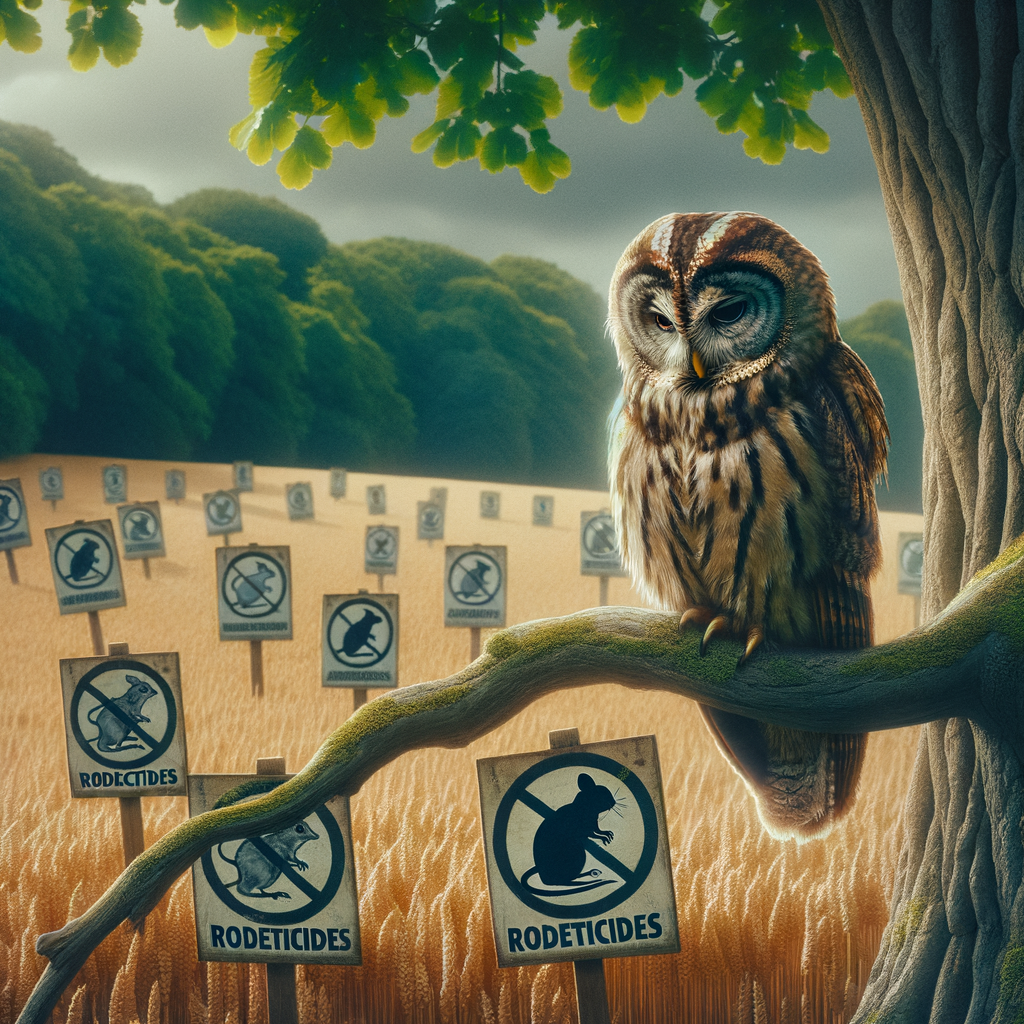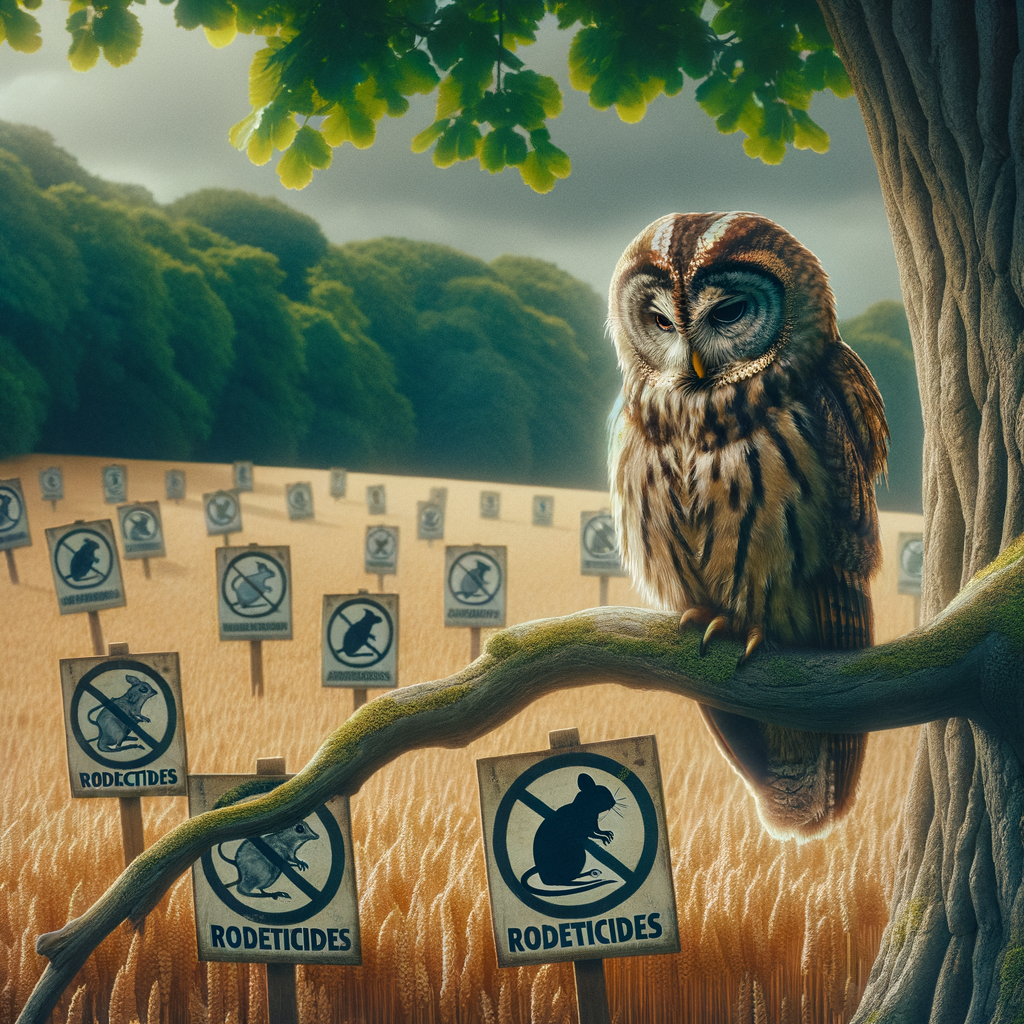
The Impact of Rodenticides on Owl Populations
-
Rodenticides and Their Use in Pest Control
Rodenticides are chemicals used to kill rodents like rats and mice. They are often used in homes, farms, and businesses to control pest populations. These chemicals can be very effective, but they also have serious side effects.
Rodenticides come in different types. Some work quickly, while others take time to kill the rodent. Unfortunately, these poisons do not only affect the targeted pests.
-
The Role of Owls in the Ecosystem
They help control the populations of small mammals, including rodents. By eating these animals, owls keep the balance in nature.
For example, a single barn owl can eat up to 1,000 mice in a year. This natural pest control is very valuable for farmers and gardeners.
-
How Rodenticides Affect Owls: Secondary Poisoning
When owls eat rodents that have ingested rodenticides, they can suffer from secondary poisoning. This means the poison from the rodent transfers to the owl.
Secondary poisoning can cause serious health problems for owls. It can make them very sick or even lead to death. Studies have shown that many owls die each year because of rodenticides.
For instance, a study found that 70% of dead barn owls in certain areas had traces of rodenticides in their bodies. This shows how widespread the problem is.
Rodenticide Effects on Wildlife: A Closer Look at Owls
Rodenticide Toxicity in Birds
-
Physiological Impact of Rodenticides on Owls
Rodenticides are chemicals used to kill rodents. However, they can also harm owls. When owls eat poisoned rodents, they ingest the rodenticide too. This can cause serious health problems.
One major effect is internal bleeding. Rodenticides can prevent blood from clotting. This means even a small injury can lead to severe blood loss. Owls may also suffer from organ damage. Their liver and kidneys can be particularly affected.
Physiological Effects Details Internal Bleeding Prevents blood from clotting, leading to severe blood loss. Organ Damage Affects liver and kidneys, causing long-term health issues. -
Behavioral Changes in Owls Due to Rodenticide Exposure
These chemicals can make owls weak and tired. They may find it hard to hunt for food. This can lead to starvation.
Owls exposed to rodenticides may also become less alert. They might not notice predators or other dangers. This increases their risk of getting hurt or killed.
In some cases, owls may become more aggressive. This can lead to fights with other owls or animals. Overall, rodenticides can make it very hard for owls to survive in the wild.
Owl Population Decline: The Silent Crisis
- Statistics on Owl Population DeclineOwl populations are decreasing at an alarming rate. According to recent studies, some species have seen a decline of up to 50% in the last 20 years. This is a worrying trend that needs immediate attention.
Owl Species Population Decline (%) Snowy Owl 30% Great Horned Owl 25% Barn Owl 50% -
Case Study: The Barn Owl
These owls are known for their heart-shaped faces and silent flight. However, their numbers are dropping fast.
One major reason is the use of rodenticides. These chemicals poison the rodents that Barn Owls eat. As a result, the owls get poisoned too. This leads to fewer Barn Owls surviving and reproducing.
Efforts are being made to protect these beautiful birds. Conservationists are working on safer pest control methods. They are also creating more habitats for Barn Owls to live and hunt.
Conservation of Owls: The Need for Action
Protecting Owl Habitats
- Preserving Natural HabitatsForests, grasslands, and wetlands are important for their food and shelter. Protecting these areas helps owls find enough food and safe places to live.
For example, the Spotted Owl lives in old forests. These forests are being cut down, making it hard for them to survive. By saving these forests, we can help Spotted Owls and other animals too.
- Creating Safe Nesting SitesOwls need safe places to nest and raise their young. Sometimes, natural nesting sites are destroyed. We can help by building nesting boxes or protecting existing nests.
For instance, the Barn Owl often nests in barns and old buildings. By keeping these structures safe, we help Barn Owls have a place to live and grow their families.
Conservation of Owls: The Need for Action
Legislation and Policy Changes
-
- Existing Laws Protecting Owls
For example, the Endangered Species Act helps protect owls that are at risk of extinction. This law makes it illegal to harm or kill these birds. Another important law is the Migratory Bird Treaty Act. This act protects owls that travel from one place to another during different seasons.
-
- Proposed Changes to Enhance Owl Conservation
New laws and policies are being proposed to help owls even more. One idea is to create more protected areas where owls can live safely. Another proposal is to limit the use of harmful chemicals like rodenticides, which can poison owls. These changes aim to create a safer environment for owls and help their populations grow.
| Law | Purpose |
|---|---|
| Endangered Species Act | Protects owls at risk of extinction |
| Migratory Bird Treaty Act | Protects migratory owls |
Rodenticides Environmental Impact: Beyond Owls
-
- Impact on Other Wildlife Species
Many other animals can be affected too. For example, hawks, eagles, and even pets like cats and dogs can get sick or die if they eat poisoned rodents. Small mammals and birds can also be at risk. This is because the poison can stay in the body of the rodent and harm any animal that eats it.
-
- Effects on Soil and Water Quality
When these poisons are used, they can seep into the soil. This can harm plants and other animals that live in the soil. Additionally, rain can wash the poison into rivers and lakes. This can harm fish and other water animals. It can also make the water unsafe for people to drink.
| Wildlife Species | Impact |
|---|---|
| Hawks | Can get sick or die from eating poisoned rodents |
| Fish | Can be harmed by poison in water |
| Soil Animals | Can be harmed by poison in soil |
Rodenticide Alternatives for Owls: Towards Safer Pest Control
Natural Pest Control Methods
- Encouraging Natural PredatorsA great way to control pests without harming owls. Owls themselves are natural predators of rodents. By creating a habitat that attracts owls, you can reduce the rodent population naturally.
For example, installing owl boxes can encourage owls to nest in your area. According to Wikipedia, a single barn owl can eat up to 1,000 rodents in a year. This method is both effective and eco-friendly.
- Using Plant-Based RepellentsThese repellents use natural ingredients to keep rodents away. For example, peppermint oil is known to repel mice and rats. You can soak cotton balls in peppermint oil and place them around your home.
Another option is to plant herbs like mint and lavender in your garden. These plants not only repel rodents but also add beauty to your surroundings. Using plant-based repellents is a simple and natural way to protect your home and the environment.
| Method | Benefits |
|---|---|
| Encouraging Natural Predators | Reduces rodent population naturally, eco-friendly, supports wildlife |
| Using Plant-Based Repellents | Safe for the environment, easy to use, adds beauty to your garden |
Technological Solutions
-
Ultrasonic Pest Repellers
Are devices that use high-frequency sound waves to keep pests away. These sounds are too high for humans to hear but can be very annoying to rodents. Studies show that these devices can reduce pest activity by up to 50% in some cases. They are easy to use and safe for other animals, including owls.
For example, a case study in a rural area found that using ultrasonic repellers led to a noticeable drop in rodent sightings. This method helps protect owls by reducing the need for harmful rodenticides.
-
Smart Traps
Advanced traps that can catch rodents without using poison. These traps often come with sensors and can send alerts to your phone when a rodent is caught. This makes it easy to monitor and manage rodent problems.
One example is the use of smart traps in urban areas. These traps have shown to be effective in catching rodents quickly and humanely. By using smart traps, we can protect owls and other wildlife from the dangers of rodenticides.
| Technological Solution | Benefits | Example |
|---|---|---|
| Ultrasonic Pest Repellers | Reduces pest activity, safe for other animals | Case study in rural area |
| Smart Traps | Catches rodents without poison, easy monitoring | Use in urban areas |






